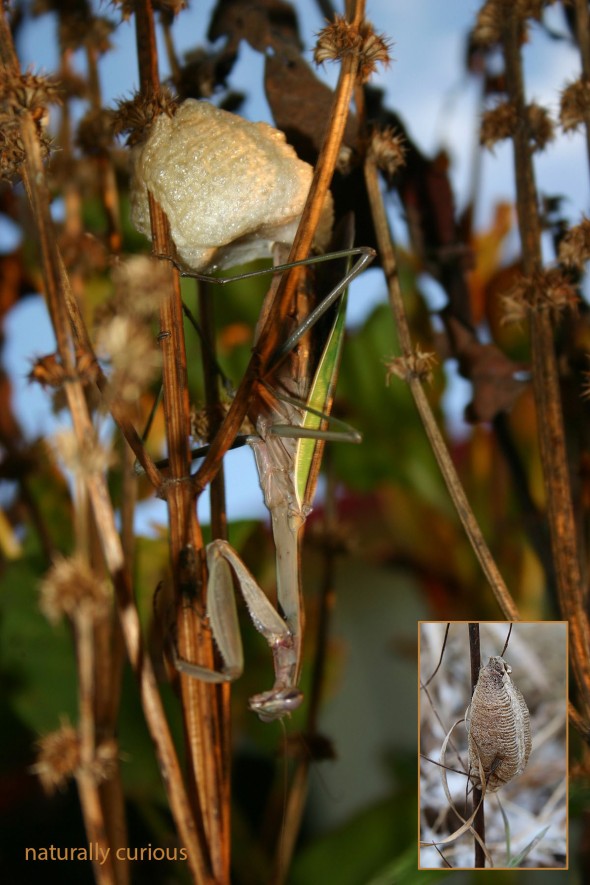Praying Mantises Mating & Laying Eggs
 In the fall, after mating, the female praying mantis lays up to 400 eggs in a frothy foam; together the eggs and the foam they are encased in are called an ootheca. This one to two-inch long mass is attached to vegetation, usually about a foot or two off the ground. Eventually the frothy structure hardens, providing a protective case for the eggs.
In the fall, after mating, the female praying mantis lays up to 400 eggs in a frothy foam; together the eggs and the foam they are encased in are called an ootheca. This one to two-inch long mass is attached to vegetation, usually about a foot or two off the ground. Eventually the frothy structure hardens, providing a protective case for the eggs.
In the spring, miniature (wingless) mantises, called nymphs, will hatch from this egg case. When hatching, the nymphs appear all at once, crawling from between tiny flaps in the case and then hanging from silk threads about two inches below the case. They are identical to adult mantises, except that they lack wings. Within an hour or two, after drying out, they disappear into nearby vegetation.
A video of a praying mantis laying her eggs and of the young mantises hatching can be seen at https://www.youtube.com/watch?v=1K2BPg7iNZA .
Thanks to Ba Rea, of Bas Relief Publishing (http://basrelief.org/ ) for the use of her West Virginian egg-laying mantis photograph.
Naturally Curious is supported by donations. If you choose to contribute, you may go to http://www.naturallycuriouswithmaryholland.wordpress.com and click on the yellow “donate” button.
September 19, 2016 | Categories: Egg laying, Insects, Praying Mantids, Predators, September, Uncategorized | Tags: ootheca, Tenodera sinensis | 5 Comments
Praying Mantis Egg Case
 In the fall, after mating, the female praying mantis lays up to 400 eggs in a frothy liquid produced by glands in her abdomen. This one to two-inch long mass is attached to vegetation, often grasses and goldenrod stalks, about a foot or two off the ground. The frothy structure hardens, providing a protective case for the eggs. In the spring, miniature (wingless) mantises, called nymphs, will hatch from this egg case. When hatching, the nymphs appear all at once, crawling from between tiny flaps in the case and then hanging from silk threads about two inches below the case. Within an hour or two, after drying out, they disappear into nearby vegetation.
In the fall, after mating, the female praying mantis lays up to 400 eggs in a frothy liquid produced by glands in her abdomen. This one to two-inch long mass is attached to vegetation, often grasses and goldenrod stalks, about a foot or two off the ground. The frothy structure hardens, providing a protective case for the eggs. In the spring, miniature (wingless) mantises, called nymphs, will hatch from this egg case. When hatching, the nymphs appear all at once, crawling from between tiny flaps in the case and then hanging from silk threads about two inches below the case. Within an hour or two, after drying out, they disappear into nearby vegetation.
Naturally Curious is supported by donations. If you choose to contribute, you may go to http://www.naturallycuriouswithmaryholland.wordpress.com and click on the yellow “donate” button.
December 9, 2013 | Categories: Arthropods, December, Egg Cases, Egg laying, Insect Signs, Insects, Invertebrates, Praying Mantids, Uncategorized | Tags: Mantodea | 6 Comments


















What Other Naturally Curious People Are Saying